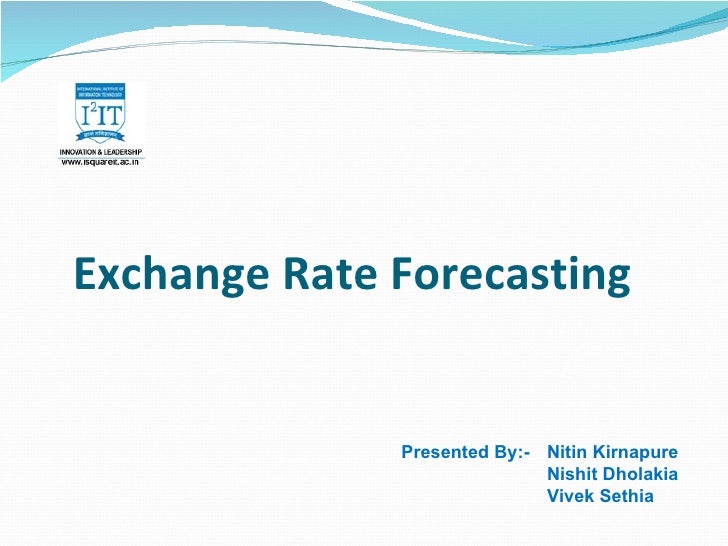Techniques of forecasting foreign exchange rates
Canadian Dollars per 1 U. Dollar Euros per 1 U. Dollar British Pounds per 1 U. Dollar Japanese Yen per 1 U.
Forecasting methods and analytical tools - OECD
Dollar Mexican Pesos per 1 U. Dollars per 1 Canadian Dollar Euros per 1 Canadian Dollar British Pounds per 1 Canadian Dollar Japanese Yen per 1 Canadian Dollar Mexican Pesos per 1 Canadian Dollar U. Dollars per 1 Euro Canadian Dollars per 1 Euro British Pounds per 1 Euro Japenese yen per 1 Euro Euros per 1 British Pound U. Dollars per 1 British Pound Japanese Yen per 1 British Pound Canadian Dollars per 1 British Pound.

Paul Krugman and Maurice Obstfeld write in their book "International Economics: Theory and Policy" New York, HarperCollins: If exchange rates are asset prices that respond immediately to changes in expectations and interest rates, they should have properties similar to those of other asset prices, for example, stock prices.
Like stock prices, exchange rates should respond strongly to "news," that is, unexpected economic and political events; and, like stock prices, they therefore should be very hard to forecast.
In a study by Richard M. Levich "Evaluating the Performance of the Forecasters", in: That does not imply that forward rates are good predictors. In fact, they usually do not predict exchange rate movements very well.
Long term movements are driven by fundamental forces, such as purchasing power parity. In the short run, exchange rate movements are driven by news and events. For excellent surveys of exchange rate theory see: The foreign exchange market: Cambridge University Press, New York, Exchange Rates and International Finance. Woodhead-Faulkner, New York, Cambridge University Press, Cambridge, IMF Staff Papers, 39 1 As pointed out above, economists do not possess reliable methods of forecasting exchange rates over short time horizons such as days or weeks.
Fundamental economic forces such as purchasing power parity and balance-of-payment disequilibrium usually take much longer, often several years, to have an effect on exchange rates. Nevertheless, the business community has to form expectations about the short-term trends of exchange rates. Because these expectations are formed by market sentiment, trends can be extrapolated. At the same time, market sentiments can change as financial news can change the outlook on a country's economic prospects.
The PACIFIC Exchange Rate Service provides two sets of exchange rates trends using two different "technical" trending techniques for day and dutch bros stock market intervals.
Trends based on techniques of forecasting foreign exchange rates fundamentals usually for quarterly or annual projections are usually obtained through large structural computational models, such as the FOCUS model of the Policy and Economic Analysis Program at the University of Toronto.

The PACIFIC trends are intended to reveal market trends, not fundamental determinants. Users of the trend charts are advised to read them with considerable caution. Understand that these make money with camtasia are not forecasts.
They do not predict the future; they only visualize current trends that can be broken at any time due to the arrival of new information. The method used in the trends is a combined quadratic trend model and autoregressive model, called a stepwise autoregressive method.
The trend component is supposed to capture long-term behaviour, while the autoregressive component is supposed to capture short-term behaviour. The autoregressive parameters included in the model for each series are selected by a stepwise regression procedure, so that autoregressive parameters are only included at those lags at which they are statistically significant.
Since the trend and autoregressive parameters are computed in sequence rather than simultaneously, there are objections against this method on a theoretical level. However, the trends are computationally inexpensive.
Forex forecasts: basic Forex forecasting techniques
The day trend diagrams are based on "runs" of exchange rate movements within a tunnel. This is essentially a heuristic trending technique. The tunnel is constructed to be as long and as narrow as possible. The tradeoff between length and width is determined by a scoring function defined by the trender. These forecasts should not be relied upon for carrying out any currency transactions which could result in injury to a person or loss of property. If you do use the forecasts in such a manner, it is at your own risk.
I disclaim all liability for direct or consequential damages resulting from your use of these forecasts. The Pacific Exchange Rate Service is located in Vancouver, Canada.
Pacific Home Page About this service Contact Pacific.